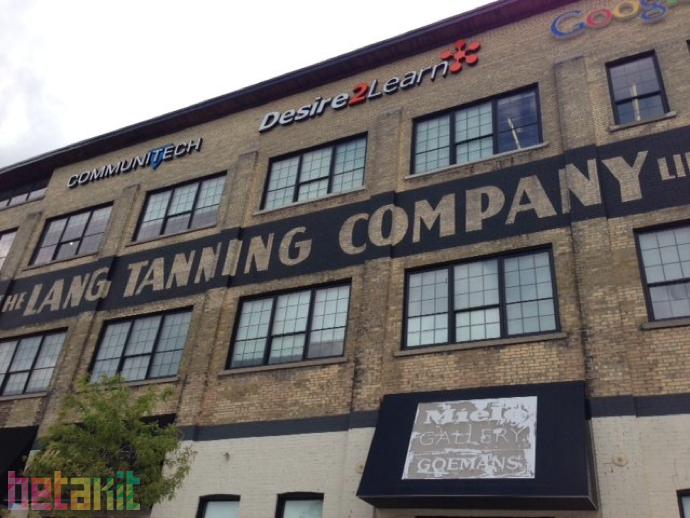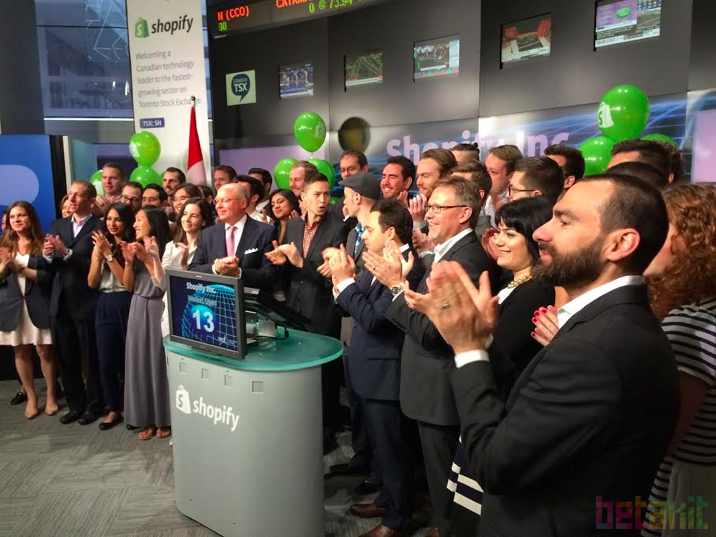If 2014 was a big year for Canadian startups, then 2015 was uncharted territory. Not only did the startup community reach a level of prominence never before seen in our fair nation, Canadian startups regularly made waves internationally.
BetaKit’s editorial team conspired together over some holiday eggnog to agree upon the biggest Canadian startup stories of 2015. As per usual, there was more eggnog than agreement.

Jessica Galang, News Editor
Some of my favourite stories have been about Canadian startups demonstrating that our ecosystem is a force to be reckoned with on the global stage. These two stories have set the stage for an ambitious 2016.
1. Shopify’s IPO
Ten years in the making, the Canadian startup community watched closely as Ottawa-based Shopify filed its IPO and hit a market value of $1.9 billion USD. The Canadian tech community can be pretty incestuous; when one of our own hits it big with a huge funding round or partnership, we’re quick to celebrate their successes and discuss it amongst ourselves.
But the Shopify IPO brought the Canadian startup scene into both the national and international spotlight. While old-school businessmen may have struggled to figure out where Shopify was from, it was clear that people outside of Canada’s tech community had realized that perhaps this is a scene worth watching.
Since then, Shopify has become a bona fide tech darling in Canada, stepping up its ecommerce game with integrations with Facebook and Twitter, and being named the CIX innovator of the year, setting off conversations about who would be the next big company to IPO. We are now living in a post-Shopify era.
2. #WaterlooRegion gets bigger and better (but no more accessible)
Waterloo has long been acknowledged to be a globally competitive startup ecosystem; in the past, startup heavyweights like Y Combinator founder Sam Altman have called the Waterloo the best up-and-coming startup city in the world, while Square and Twitter co-founder Jack Dorsey noted that the University of Waterloo and the city’s support for startups made it a prime destination for seeking top engineering talent.

In 2015, #WaterlooRegion was reported to have the second largest startup density in the world, second only to Silicon Valley, with large companies continued to make moves to snag a place in the burgeoning tech community. TD and Shopify collectively helped create 420 jobs in the region, while Communitech saw established institutions like Thomson Reuters move in to open data and innovation labs.
Speaking of Communitech, with Google expanding to larger digs, the University of Waterloo’s Velocity program and Communitech took over Google’s former space in 2015. It’s not the end of Google and Communitech’s relationship, though, as the two institutions currently have a three-year partnership through the Google for Entrepreneurs program and Communitech’s women in technology initiatives.
One minor caveat to the Waterloo Region hype, however. As Waterloo gets hot, entrepreneurs are demanding the infrastructure to support it, including Stephen Lake calling poor transit a major issue for the city’s ecosystem. Whether or not that problem is solved will be a huge story in 2016.

Tom Emrich, Senior Editor
I’m in Vegas right now for CES, so my pick has a bit of an international flavour as well. But this story was a leading indicator of what we’ll see in the Canadian wearables sector in 2016.
1. Google Glass: gone but not forgotten (or gone)
It may have happened right at the beginning of the year, but my top story for 2015 would have to be the shut down of the most important wearable tech program in history, the Google Glass Explorer program. With Glass being such a pinnacle device in the emerging wearable space, Google’s “graduation” of Glass out of the Google X program caused a huge stir in the media with many taking this as a sign that Google had failed with its device overloading the internet with “Glass is dead” headlines. I attempted to clarify what exactly the program change meant to Glass and the wearable space, suggesting that Glass would resurrect in the enterprise.

During the holiday break, news broke of Google Glass 2.0 being spotted during its review by the FCC, with reports confirming Glass’ next step as a tool for businesses. One of my predictions for wearables this year is that we will hear many success stories from the enterprise in the use of wearables, including HUD and AR devices like Glass, so expect to hear a lot more about enterprise wearables in 2016.

Elena Yunusov, Senior Editor
Another tough year has come and gone, but did we have a good time here at BetaKit? You bet we did. With so many great stories to tell, it’s incredibly hard to pick the biggest stories of the year, but here we go.
1. Design: what is it good for? Your brand.
2015 was an odd time for the design community in Toronto. We talked to Jon Lax about Teehan+Lax closing doors, covered the end of HEIST, and what that meant for the city. While other notable shops in town like Jam3, Normative, and SayYeah picked up pace in 2016, many startups still tend to cut corners on design. So it’s been refreshing to see startups like Wealthsimple treating good design and UX as a strong competitive advantage with its rebrand and marketing (go ahead and read the full story).
“Assuming you have your product and team and operations right, we believe you can win on brand. Sometimes, in the startup community, we get hyper focused on paid acquisition and what channels are working. But brand is very important part of organic and paid acquisition – and every channel is amplified by brand. For startups in early stages, it was typically about finding a domain name that was available, a logo from 99designs, and a tagline you’d DIY. Now, we recognize that a brand really can be a force-multiplier,” Michael Katchen, CEO of Wealthsimple told BetaKit.

Here’s to more companies realizing that design is integral to not only how their product works, but their brand, too, in 2016. Hacking growth, customer success, and retention with design? Sounds like a worthwhile pursuit for the new year.
2. “I’m a card-carrying member of the Startup Party.”
One of the biggest developments of 2015 has got to be the new startup lobby group that aims to use government for leverage, started by John Ruffolo of OMERS Ventures, and joined by Shopify, Hootsuite, Wattpad, D2L, InteraXon, Hatch, eSentire, and Global Relay as confirmed companies in this initial coalition. Fun policy issues such as taxation frameworks came up during the election and mobilized the community’s heavy hitters, who have already affected policy discussions. While startups at different stages of growth may find it hard to agree on priorities, more continuous dialogue between the startup community and various levels of government is a good thing.
As Ruffolo wrote on BetaKit himself earlier in 2015, “Industries do not get built by accident. While the startup community must be built and led by the entrepreneurs, they cannot do it alone… The real question in my mind is, “has the startup community actually told the Government what we do and do not want?” That’s a great question for 2016.

Jonathon Narvey, West Coast Editor
I’m checking in from rainy Vancouver, so all my hot takes are three hours behind.
1. Slack’s success story shows us how tech can work for us
It’s not every day that a Vancouver-based company achieves a $2.8 billion valuation – but the team collaboration and communication app known as Slack is showing that Canadian companies don’t have to sell out to grow big. While the investment in and rapid growth of Slack is a story in itself, it’s the story of how this company got there that is turning heads. Founder and CEO Stewart Butterfield has been painfully honest about this process and how he managed to turn around a failing game company that was down to its last bits of funding, by recognizing the real value in what they had built. Their pivot to success and strategies for managing growth are now go-to case studies other tech startups can use to work smarter towards achieving their own goals.
2. BC bets big on tech
“They’ll say our government shouldn’t pick winners – but virtually every other country is already doing that,” said one of the longest-running VC firms on Canada’s west coast this year. Just a short time later, we had BC Premier Christie Clark announce a new $100 million VC fund to help the west coast’s scrappy startups grow up to be world-beaters.
The fund officially launches this month, but some of Vancouver’s most enthusiastic tech execs are already thinking about what it can mean to their niches; as CEO Kevin Sandhu of Grow put it, this new fund helps cement this region’s position as a global tech leader (“Pool of mentors… Check! Desirable place to live? Government support? Accessible startup capital? Check, check, check!”). While there are dissenting opinions, it’s a big shift from our old paradigm as lumberjacks and hewers of wood and water. Many left coast tech visionaries have already noted that BC’s tech industry is not just outpacing the resource sector that has traditionally driven jobs and growth here, it’s super-charging those traditional industries, as well – and a rising tide lifts all boats.

Douglas Soltys, Editor-in-Chief
I get to go last, as you all forced me to edit your work over the holidays. Which, of course, means that all the big stories have been chosen, so I’ll try to fill in where I can.
1. The (Canadian Startup) Force Awakens
Much like Elena, I believe that 2015 was the year Canadian startups stopped worrying so much about being accepted internationally and started throwing their weight around. Shopify’s IPO and Slack’s rocketship growth certainly helped, but I pinpoint the exact moment the mojo crystallized into a hardened gestalt was on a clear September evening at Razor Suleman’s house.

The Spotlight Awards brought together a generation of Canada’s most successful tech entrepreneurs in one room to celebrate past battles won and ruminate on future opportunities. Is it at all surprising that just days later our tech elite was forcing policy changes during a federal election (kicked off by a BetaKit article, no less), or just two months later forming a national lobby? Nope.
I don’t expect the Maple Syrup Mafia to be any less imposing in 2016. More so, in fact.
2. Hardware founders, but not hardware CEOs
Startups are hard. Hardware startups are really, really hard. Tom has argued that 2015 was the year the hype bubble burst for wearable tech (spoiler: 2016 won’t be much better), but I am much more interested in what was happening behind the scenes. 2015 saw no less than three founders from high-profile hardware companies in Canada step down as CEO: first Bubl, then Nymi, and finally InteraXon.
Now, the reasons for swaps at the top varied wildly for each company, but the regularity at which this is occurring in Canada is striking. It’s not uncommon in the startup space to see CEO founders eventually take on different roles, as building a company and running it are very different things. But perhaps the long development times, significant costs, and nascent markets make hardware startups an even more difficult tightrope to walk.
I wouldn’t be surprised if we see a few more hardware founders step aside in 2016. We’ll definitely be paying attention.


